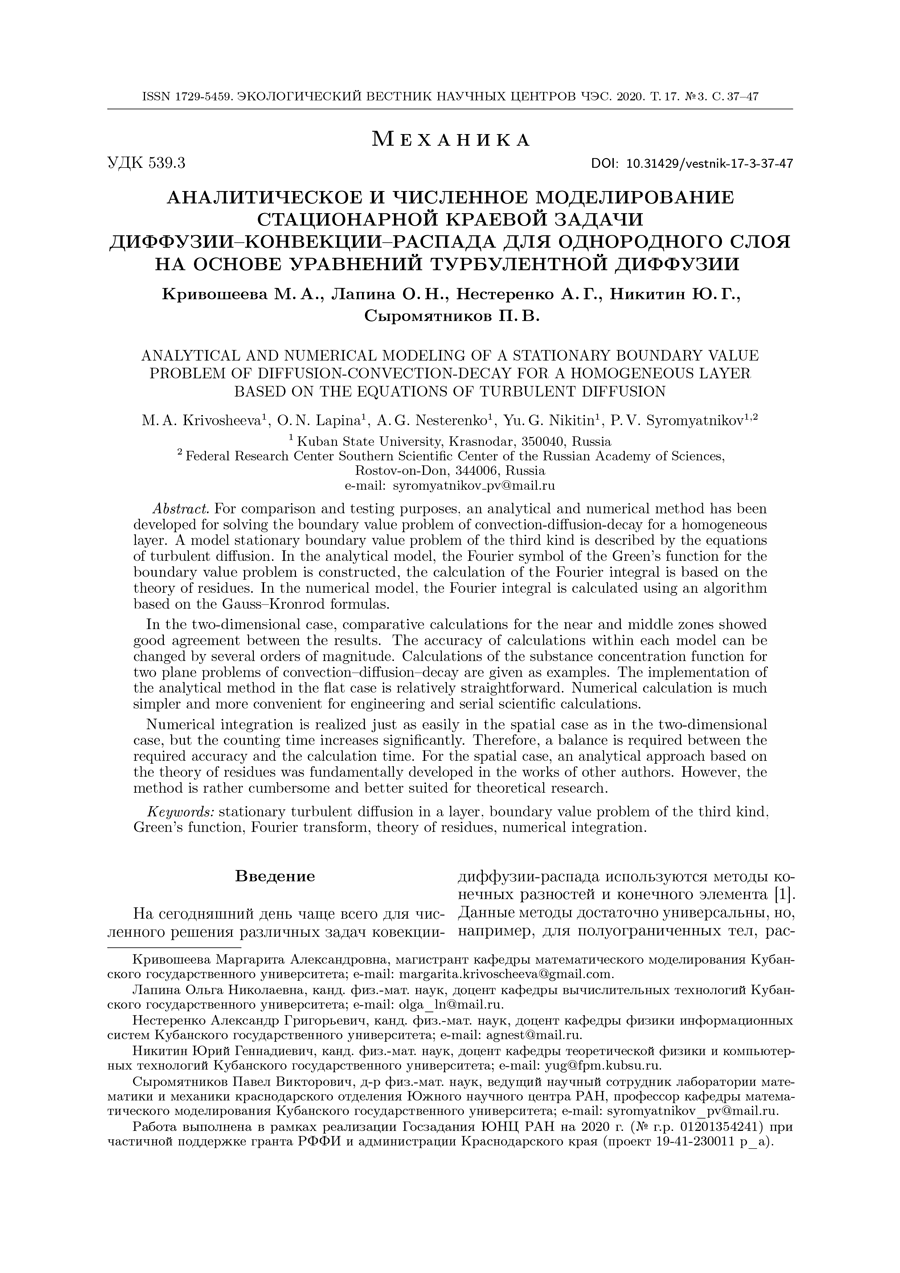Analytical and numerical modeling of a stationary boundary value problem of diffusion-convection-decay for a homogeneous layer based on the equations of turbulent diffusion
UDC
539.3DOI:
https://doi.org/10.31429/vestnik-17-3-37-47Abstract
For comparison and testing purposes, an analytical and numerical method has been developed for solving the boundary value problem of convection-diffusion-decay for a homogeneous layer. A model stationary boundary value problem of the third kind is described by the equations of turbulent diffusion. In the analytical model, the Fourier symbol of the Green's function for the boundary value problem is constructed, the calculation of the Fourier integral is based on the theory of residues. In the numerical model, the Fourier integral is calculated using an algorithm based on the Gauss-Kronrod formulas.
In the two-dimensional case, comparative calculations for the near and middle zones showed good agreement between the results. The accuracy of calculations within each model can be changed by several orders of magnitude. Calculations of the substance concentration function for two plane problems of convection-diffusion-decay are given as examples. The implementation of the analytical method in the flat case is relatively straightforward. Numerical calculation is much simpler and more convenient for engineering and serial scientific calculations.
Numerical integration is realized just as easily in the spatial case as in the two-dimensional case, but the counting time increases significantly. Therefore, a balance is required between the required accuracy and the calculation time. For the spatial case, an analytical approach based on the theory of residues was fundamentally developed in the works of other authors. However, the method is rather cumbersome and better suited for theoretical research.
Keywords:
stationary turbulent diffusion in a layer, boundary value problem of the third kind, Green's function, Fourier transform, theory of residues, numerical integrationAcknowledgement
References
- Samarsky, A.A., Vabishchevich, P.N. Numerical methods for solving convection-diffusion problems. Librokom, Moscow, 2015. (In Russian)
- Samarov, Sh.Sh. Exact and approximate analytical methods for solving direct, contact and inverse problems of heat conduction. Abstract ... cand. physical-mat. sciences. Dushanbe. 2004. (In Russian)
- Babeshko, V.A., Pavlova, A.V., Babeshko, O.M., Evdokimova, O.V. Mathematical modeling of ecological processes of the spread of pollutants. Krasnodar, Kuban State University, 2009. (In Russian)
- Beckman, I.N. Higher mathematics: the mathematical apparatus of diffusion. Yurayt Publishing House, Moscow. 2018. (In Russian)
- Krasnov, M.L., Kiselev, A.I., Makarenko, G.I. Complex variable functions. 3rd ed. Fizmatlit, Moscow, 2003. (In Russian)
- International library of mathematical subroutines IMSL. Available at: https:// www.roguewave.com/products-services/imsl-numerical-libraries (date accessed: 15.08.2020).
- Notaris, S.E. An overview of results on the existence and nonexistence and the error term of Gauss – Kronrod quadrature formulas. In: Zahar R.V.M. (ed.) Approximation and Computation, Birkhäuser, 1995, pp. 485–496.
- Kosobutskaya, E.V. Some models of the spread of hazardous pollutants in stationary conditions. Abstract ... cand. physical-mat. sciences, Krasnodar, 1998. (In Russian)
- Syromyatnikov, P.V., Krivosheeva, M.A., Lapina, O.N., Nesterenko, A.G., Nikitin, Yu.G. Statsionarnyye protsessy diffuzii-konvektsii-raspada v odnorodnom poluprostranstve [Stationary diffusion-convection-decay processes in a homogeneous half-space]. Ekologicheskiy vestnik nauchnykh tsentrov Chernomorskogo ekonomicheskogo sotrudnichestva [Ecological Bulletin of Research Centers of the Black Sea Economic Cooperation], 2019, vol. 16, no. 4, pp. 31–42. DOI: 10.31429/vestnik-16-4-31-42 (In Russian)
Downloads
Submitted
Published
How to Cite
Copyright (c) 2020 Krivosheeva M.A., Lapina O.N., Nesterenko A.G., Nikitin Yu.G., Syromyatnikov P.V.

This work is licensed under a Creative Commons Attribution 4.0 International License.




